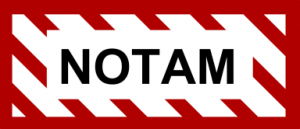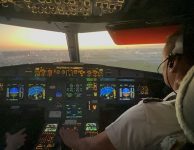Drinking From a Firehose Part 2—The Matrix
Drinking From a Firehose Part 2—The Matrix
Ladies and Gents, from the Flight Blog, this is your Cap’n Aux speaking. Sit down and strap in—we’re in for a mighty turbulent ride!
Oh, and…Take the Blue Pill—we’re going in!

As we explored last week, airline pilot training has evolved considerably. And, there’s been no more amazing technological advances than the full-motion airline simulator. The training is so realistic, it’s like being plugged into Neo’s Matrix.
Or, if you prefer, the simulator is perhaps more akin to the Enterprise Holodeck…

In any case, if you were to be led, blindfolded, into the Capn’s seat of a full-motion simulator and then opened your eyes, you’d swear you were in the skies flying the real deal!
A Snowy Day in KBOS. Or is it, Neo?
Media error: Format(s) not supported or source(s) not found
Download File: https://capnaux.com/wp-content/uploads/2021/11/Sim-Snow-low-no-audio.mp4?_=1Download File: https://capnaux.com/wp-content/uploads/2021/11/Sim-Snow-low-no-audio.mp4?_=1Drinking From a Firehose Part 2—The Matrix and the FAA
The last time I trained for a new type rating (to fly my A320 as a Captain), 99% of our training was in the sim. It’s still pretty much the same today, because of the obvious advantage of simulators: unlike flying a real airplane, emergencies such as inflight engine fires and failures can be “simulated.”
This thorough training is so effective that an airline pilot can be fully trained and type rated in an airplane without ever having set foot on the real deal.
In a way, a type rating is merely the beginning, however. Once you’re legally rated in a plane, then you’ve got to go out and fly it for real, with a Check Airman.
(More on that to follow.)
All modern airliners require a specific "type rating" to fly. This applies to each individual model of airliner. For example, Cap'n Aux has type ratings in: the DHC Dash 8, Boeing 737, and Airbus A320.
The Type Rating

Notices to Airmen
The Hardcover edition of The Last Bush Pilots has Arrived!









She’s pulled into the gate, and ready for pickup at Baggage Claim—click on the button below to check it out!

Drinking From a Firehose Part 2—The Simulator Training
Each day, FO Thurston and I spend four intense hours in “The Sweat Box.”
First comes a 2-hour briefing on the maneuvers and procedures (and some failures) that we will be practicing, followed by a post-sim evaluation and critique of our performance and learning.
As of this writing, in a couple hours, Thurston and I will show up for our 4-hour practice of…engine failures and fires on takeoff!
Yesterday—merely our second session with the full-motion on—also saw multiple instrument approaches, a hydraulic failure, a cargo fire, and emergency evacuation.
Tomorrow’s adventure: Rapid decompression/Emergency descents, dual computer failures, recoveries from extreme flight upsets, near-0 visibility approaches, and myriad other “non-normals” too numerous to mention.
Oh, yeah, and occasionally we practice stuff with everything actually working!
Nope, this sim stuff ain’t for the faint-hearted!

While it’s intense, it’s also a fantastic learning environment—and, I daresay, dang FUN!
Of course, it helps greatly that our grizzled ol’ sim instructor Jim is full of jokes and likes to keep it a positive learning environment. He tends to teach more by joke than whip.
That’s fine by us—pilots are always their own worst critics, anyway!
Drinking From a Firehose Part 2—The Simulator: Impressions
In general, “the bigger the plane, the easier it is to fly,” and the 777 is no exception. There are so many automated aids for the pilot, such as automatic rudder compensation for an engine failure. This is enormously helpful on our “V1 cuts,” where we practice an engine failure or fire at the worst possible moment: right when we’re about to pull up on takeoff.
Of course, anything automated (or man-made) can fail, so every “aid” comes with its own failure practice as well.












One huge advantage that Thurston and I bring to the table is that we have been “flying the line” for our company for some time now, and are used to SOP (Standard Operating Procedures). While each particular airplane has its nuances, these SOPs are mostly standardized across the Company fleet, which has allowed us to feel at home in our new environment.
Joystick vs. Yoke
When transitioning to the Airbus, one of the most common questions I got was, “How long did it take to get used to the sidestick?”
My answer: About 5 minutes!
Now, I’m getting the same question in reverse: “How is it going back to a control column?”
This time, my answer is: It’s like riding a bicycle!
To tell the truth, I didn’t even think of it; it just came naturally. Perhaps because all other planes that I’ve flown, except for the Airbus, had the control column.
In any case, while I’ll miss being able to pull out the tray table or cross my legs, I’m plenty happy with getting back to some classic flight controls.
Bus Driver to Taxi Man
Ask any Cap’n, and they will tell you the toughest part of flying is…
Taxiing!
You’ve always got to stay oriented, so you don’t, say, accidentally taxi across an active runway. And, you’ve got to keep those big ol’ ginormous wings and long tail from going around hitting things.

That said, I’m happy to say that taxiing the 777 has been surprisingly easy. The new perspective is very similar to my old one in the Airbus.
The ol’ Airbus taxi tiller took some getting used to, in order to finesse. The 777? The tiller is bigger and less sensitive, but pretty straightforward. It takes broad motions rather than finesse to navigate the taxiways, but that also makes it more predictable and forgiving. Things feel intuitive, and my only real perception change is having to begin a turn a tad later than I’m used to—because the nose wheels are about 10 feet behind the flight crew!

What’s more, our -300 ER models come with an optional video camera of the ground, which is a fantastic aid to see if I’m “in the ballpark” of where I should be, taxi-wise.
(See pics, above and below.)

Like all simulators seem to be, I’m told that the sim flies like the real deal, but is actually slightly harder to land!
Drinking From a Firehose Part 2—The Matrix: Final Phase
Our two weeks of daily simulator sessions marks “Phase 3” of the 4-phase flight training course. This phase will end with 2 days of tests—basically, an evaluation of our knowledge, proficiency, and skills required to safely fly the Big Bird on the line.
If all goes well and we pass Phase 3, FO Thurston and I will both earn our wings: the coveted “Type Rating” in the Boeing 777!
(Note: current rules require the FO to be type rated as well.)
If this sim’s rockin’, don’t come knockin’!
As mentioned above, Phase 4 will consist of flying the beast with a Check Airman, who will, in effect, “baby sit” me on my first several flights. Further, I will also have to be checked out in certain special airports and “theatres” (Europe, S. America, Asia, etc.)
Once s/he signs me off…well, then, I’ll be back to the line, flying my new behemoth!
Drinking From a Firehose Part 2—The Simulator: Conclusion
I was told that the B777 is known as “the gentleman’s course,” and I’m inclined to agree. While certainly a major challenge, training has been surprisingly “easy”, insofar as I’ve been able to sufficiently gulp from that firehose enough to keep afloat.
A stormy day in KJFK. Or is it, Neo?
Media error: Format(s) not supported or source(s) not found
Download File: https://capnaux.com/wp-content/uploads/2021/12/jfk-tstorm.mp4?_=2Download File: https://capnaux.com/wp-content/uploads/2021/12/jfk-tstorm.mp4?_=2Moreover, I’ve been in the Left Seat of an airliner for over 20 years now, and, while the new plane is different, the old job is the same. A few more bells and whistles and procedures added, perhaps, but basically I’ll be doing what I’ve done for years: fly!
So, when I do hit the line again, I feel like “the real deal” will be no big deal at all!
While I won’t exactly be able to dodge bullets like Neo and Co., I will be able to take that red pill once again, and get back to flying in the real world—which, we now know, is nothing more than a “simulation” of the simulator world!

So, I ask you once again, Neo: which is real, and which is simulation?
Till the next post,
This is Cap'n Aux...

Simulating Off!
Related Links
- Drinking From a Firehose Part 1 https://capnaux.com/drinking-from-a-firehose-part-1/
- Fifi’s Final Flight! https://capnaux.com/fifis-final-flight/
- Cap’n Aux Books https://www.amazon.com/Eric-Auxier/e/B00971H8VW
- End of an Aviation Era https://capnaux.com/end-of-an-aviation-era/
- A Tale of Two Upgrades https://capnaux.com/a-tale-of-two-upgrades/
- As the Turbine Turns https://capnaux.com/as-the-turbine-turns/
- The Bid Life of an Airline Pilot https://capnaux.com/the-bid-life-of-an-airline-pilot/
- An Airline Pilot Retires https://capnaux.com/an-airline-pilot-retires/
- Cap’n Aux Vimeo Page https://vimeo.com/capnaux/
- All Word on the Ramp Videos https://vimeo.com/manage/showcases/3162370/info
- Best of Videos https://vimeo.com/manage/showcases/3162373/info
- Pilots of the Caribbean https://capnaux.com/there-i-wuz-pilot-of-the-caribbean/
- Part 2: Stranded in Paradise https://capnaux.com/pilot-of-the-caribbean-part-2/
- The Airline Cockpit in 7 Steps https://capnaux.com/airline-cockpit-7-steps-updated/
- Top 10 Downers of an Airline Pilot Career https://capnaux.com/top-10-downers-of-an-airline-career/
- Top 10 Things to Never Say to a Pilot https://capnaux.com/top-things-never-to-say-to-a-pilot/
- Pilots Protest Covid Mandates https://capnaux.com/pilots-protest-covid-mandates/
- The Post-Covid Future of US Aviation https://capnaux.com/the-post-covid-future-of-u-s-aviation/
- Flying in the Age of Covid https://capnaux.com/flying-during-covid/
- Life of a Test Pilot https://capnaux.com/the-occasionally-exciting-life-of-a-test-pilot/
- WOTR Video: It’s What Pilots Do! https://capnaux.com/word-on-the-ramp-video-its-what-pilots-do/
- Confessions of a Former Airline Pilot https://capnaux.com/confessions-of-a-former-airline-pilot/
- The Making of a European Pilot https://capnaux.com/the-making-of-a-european-airline-pilot/
- Lessons From the Miracle on the Hudson https://capnaux.com/forced-landings-pilot-lessons-from-the-miracle-on-the-hudson-part-1/







